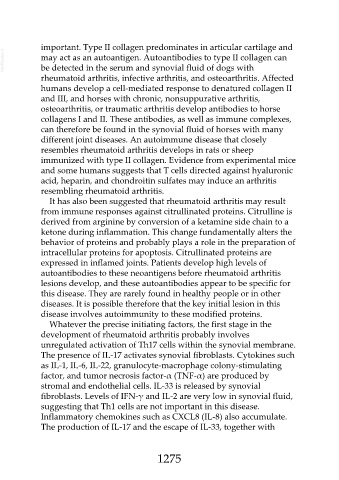Page 1275 - Veterinary Immunology, 10th Edition
P. 1275
important. Type II collagen predominates in articular cartilage and
VetBooks.ir may act as an autoantigen. Autoantibodies to type II collagen can
be detected in the serum and synovial fluid of dogs with
rheumatoid arthritis, infective arthritis, and osteoarthritis. Affected
humans develop a cell-mediated response to denatured collagen II
and III, and horses with chronic, nonsuppurative arthritis,
osteoarthritis, or traumatic arthritis develop antibodies to horse
collagens I and II. These antibodies, as well as immune complexes,
can therefore be found in the synovial fluid of horses with many
different joint diseases. An autoimmune disease that closely
resembles rheumatoid arthritis develops in rats or sheep
immunized with type II collagen. Evidence from experimental mice
and some humans suggests that T cells directed against hyaluronic
acid, heparin, and chondroitin sulfates may induce an arthritis
resembling rheumatoid arthritis.
It has also been suggested that rheumatoid arthritis may result
from immune responses against citrullinated proteins. Citrulline is
derived from arginine by conversion of a ketamine side chain to a
ketone during inflammation. This change fundamentally alters the
behavior of proteins and probably plays a role in the preparation of
intracellular proteins for apoptosis. Citrullinated proteins are
expressed in inflamed joints. Patients develop high levels of
autoantibodies to these neoantigens before rheumatoid arthritis
lesions develop, and these autoantibodies appear to be specific for
this disease. They are rarely found in healthy people or in other
diseases. It is possible therefore that the key initial lesion in this
disease involves autoimmunity to these modified proteins.
Whatever the precise initiating factors, the first stage in the
development of rheumatoid arthritis probably involves
unregulated activation of Th17 cells within the synovial membrane.
The presence of IL-17 activates synovial fibroblasts. Cytokines such
as IL-1, IL-6, IL-22, granulocyte-macrophage colony-stimulating
factor, and tumor necrosis factor-α (TNF-α) are produced by
stromal and endothelial cells. IL-33 is released by synovial
fibroblasts. Levels of IFN-γ and IL-2 are very low in synovial fluid,
suggesting that Th1 cells are not important in this disease.
Inflammatory chemokines such as CXCL8 (IL-8) also accumulate.
The production of IL-17 and the escape of IL-33, together with
1275

